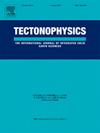Seismicity, faulting, and the magmatic fluid influence: Insights from the 2023 ML5.4 earthquake sequence in the Beibu Gulf
IF 2.6
3区 地球科学
Q2 GEOCHEMISTRY & GEOPHYSICS
引用次数: 0
Abstract
The Beibu Gulf and its surroundings represent a significant intraplate seismic zone in the northwest of the South China Sea. Historically, this region has experienced at least 15 M > 5 earthquakes and 4 M > 6 events, including a devastating M7.5 earthquake in 1605. Despite the serious earthquake risk in this seismic zone, few studies have focused on the moderate to strong earthquake sequences, resulting in unclear seismic structures, mechanisms, and triggers. This study investigates the 2023 Beibu Gulf (BBG) earthquake sequence (ML5.4) using four months of waveform data from 51 broadband stations. We detected one foreshock and 73 aftershocks using template matching techniques, relocated the earthquake sequence with the HypoDD method, and inverted focal mechanisms for 12 M > 1.5 earthquakes. The results indicate that the 2023 BBG earthquake sequence forms a belt in the NWW-SEE direction, extending laterally ∼5.0 km and vertically ∼1.5 km, with a dip angle of ∼52° toward the NNE. Most foreshocks and aftershocks exhibit source mechanisms similar to the mainshock, corresponding with the NWW-trending Wei-2 Fault (F1). The principal stress direction in the source region is NW-SE, intersecting obliquely with the F1, resulting in the right-lateral strike-slip faulting of the 2023 BBG earthquake sequence. Ambient noise tomography reveals a deep columnar low-velocity zone beneath the sequence, suggesting a possible relationship with magmatic-hydrothermal fluids from the Hainan mantle plume. By integrating seismic activity characteristics and geological data, we conclude that deep hydrothermal fluids and fault structures or weak zones are the primary driving factors of seismicity in this region.
北部湾2023年ML5.4地震序列的地震活动性、断裂和岩浆流体影响
北部湾及其周边地区是南海西北部一个重要的板内地震带。从历史上看,该地区至少经历了15次并购;5次地震和4次地震;6次地震,包括1605年毁灭性的7.5级地震。该地震带地震危险性较大,但对中~强地震序列的研究较少,导致地震结构、机制和触发因素不明确。本文利用51个宽频站4个月的波形数据,对2023年北部湾地震序列(ML5.4)进行了研究。我们利用模板匹配技术检测到1次前震和73次余震,利用HypoDD方法重新定位地震序列,并反演了12 M >的震源机制;1.5地震。结果表明,2023年BBG地震序列在NWW-SEE方向形成一条横向延伸~ 5.0 km,纵向延伸~ 1.5 km,倾角为~ 52°的北北东向地震带。大多数前震和余震的震源机制与主震相似,与北西向的威2断层(F1)相对应。震源区主应力方向为NW-SE,与F1斜相交,形成2023年BBG地震序列的右旋走滑断裂。环境噪声层析成像显示,层序下方存在深部柱状低速带,可能与海南地幔柱岩浆热液流体有关。综合地震活动特征和地质资料,认为深部热液流体和断裂构造或薄弱带是本区地震活动的主要驱动因素。
本文章由计算机程序翻译,如有差异,请以英文原文为准。
求助全文
约1分钟内获得全文
求助全文
来源期刊

Tectonophysics
地学-地球化学与地球物理
CiteScore
4.90
自引率
6.90%
发文量
300
审稿时长
6 months
期刊介绍:
The prime focus of Tectonophysics will be high-impact original research and reviews in the fields of kinematics, structure, composition, and dynamics of the solid arth at all scales. Tectonophysics particularly encourages submission of papers based on the integration of a multitude of geophysical, geological, geochemical, geodynamic, and geotectonic methods
 求助内容:
求助内容: 应助结果提醒方式:
应助结果提醒方式:


